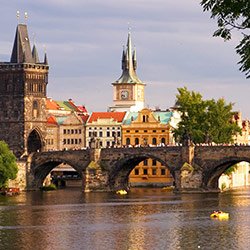Fluid Transport and Hydraulic Machinery
Engineering & Social Sciences Program
Madrid, Spain
Dates: 8/30/25 - 12/20/25

Fluid Transport and Hydraulic Machinery
OVERVIEW
CEA CAPA Partner Institution: Universidad Carlos III de Madrid
Location: Madrid, Spain
Primary Subject Area: Energy Engineering
Instruction in: English
Course Code: 15094
Transcript Source: Partner Institution
Course Details: Level 300
Recommended Semester Credits: 3
Contact Hours: 42
Prerequisites: - All previous courses on Mathematics (Calculus, Algebre, etc.)
- Engineering Fluid Mechanics
DESCRIPTION
This is an eminently practical course, so the student must master the necessary fundamental knowledges at the time on enrollment.
CHAPTER 1: Steady flow of liquids in ducts
1.1 Primary head losses. Colebrook correlation and Moody's chart.
1.2 Non-circular cross-section ducts. Hydraulic diameter.
1.3 Localized head losses: Valves, Elbows, curves, expansions, contractions, etc.
1.4 Coupling of turbomachinery to hydraulic facilities.
CHAPTER 2: Steady flow of liquids in pipe networks.
2.1 Pipes in series and in parallel.
2.2 Analysis of branched ducts: the three-reservoirs problem.
2.3 Analysis of closed-loop pipe networks. Matrix algorithm and its numerical implementation.
CHAPTER 3: Unsteady phenomena in pipe flow.
3.1 Theory of unsteady incompressible flow in ducts.
3.2 Characteristic acceleration and discharge times. Quasi-steady flow.
3.3 Order-of-magnitude analysis of characteristic variables in unsteady pipenetworks flow. Non-dimensionalization of the equations.
3.4 Applications. Surge tanks.
3.5 Compressibility effects. Basic theory of water hammer. Reflection and transmission of waves. Applications.
CHAPTER 4: Introduction to turbomachinery.
4.1 Definitions. Classification of incompressible fluid machines.
4.2 Characteristic curves of pumps ad turbines.
4.3 Cavitation in turbomachinery.
4.4 Similarity in pumps.
4.5 Similarity in turbines.
4.6 Coupling of pumps and turbines to a hydraulic network.
CHAPTER 5: Introduction to open channel flow.
5.1 Definitions.
5.2 Uniform flow in channels. Manning¿s formula. Optimal sections.
5.3 Specific energy.
5.4 Rapidly varying flow. Flow around obstacles
5.5 Hydraulic jumps and weirs.
CHAPTER 1: Steady flow of liquids in ducts
1.1 Primary head losses. Colebrook correlation and Moody's chart.
1.2 Non-circular cross-section ducts. Hydraulic diameter.
1.3 Localized head losses: Valves, Elbows, curves, expansions, contractions, etc.
1.4 Coupling of turbomachinery to hydraulic facilities.
CHAPTER 2: Steady flow of liquids in pipe networks.
2.1 Pipes in series and in parallel.
2.2 Analysis of branched ducts: the three-reservoirs problem.
2.3 Analysis of closed-loop pipe networks. Matrix algorithm and its numerical implementation.
CHAPTER 3: Unsteady phenomena in pipe flow.
3.1 Theory of unsteady incompressible flow in ducts.
3.2 Characteristic acceleration and discharge times. Quasi-steady flow.
3.3 Order-of-magnitude analysis of characteristic variables in unsteady pipenetworks flow. Non-dimensionalization of the equations.
3.4 Applications. Surge tanks.
3.5 Compressibility effects. Basic theory of water hammer. Reflection and transmission of waves. Applications.
CHAPTER 4: Introduction to turbomachinery.
4.1 Definitions. Classification of incompressible fluid machines.
4.2 Characteristic curves of pumps ad turbines.
4.3 Cavitation in turbomachinery.
4.4 Similarity in pumps.
4.5 Similarity in turbines.
4.6 Coupling of pumps and turbines to a hydraulic network.
CHAPTER 5: Introduction to open channel flow.
5.1 Definitions.
5.2 Uniform flow in channels. Manning¿s formula. Optimal sections.
5.3 Specific energy.
5.4 Rapidly varying flow. Flow around obstacles
5.5 Hydraulic jumps and weirs.










